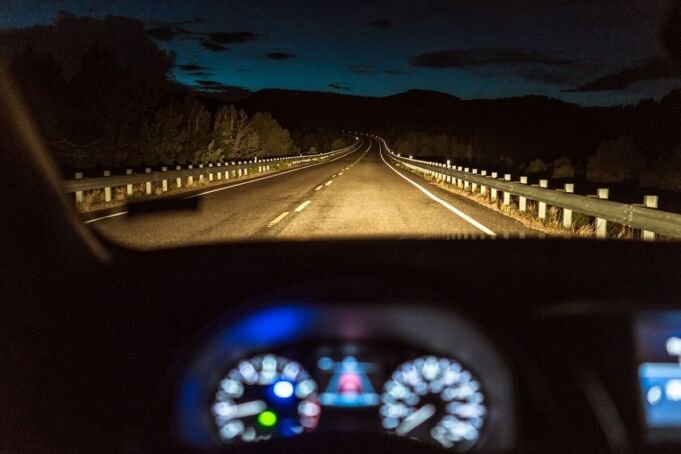Road trips captivate many with their promise of freedom and adventure. Planning a route through beautiful scenery and exploring new areas captures the essence of adventure. The excitement often starts with choosing when to begin the journey.
Some like to set off at dawn, but others might choose to start late at night, aiming to travel far while others sleep. Yet, starting a road trip at night, although tempting, carries considerable risks. This article explores why starting a road trip late at night might not be the best idea.
Why Shouldn’t You Start A Road Trip Late in the Night?
Driving late at night comes with several safety risks. Here are key concerns to think about before starting a late-night road trip:
Increased Risk of Drowsy Driving
One of the most significant risks of starting a road trip late at night is drowsy driving. Our body’s natural sleep cycle, or circadian rhythm, typically signals us to rest during the night. Ignoring these signals can lead to reduced alertness and slower reaction times. Studies have shown that drowsy driving can be as dangerous as drunk driving. According to the National Sleep Foundation, drowsy driving is responsible for over 6,400 U.S. deaths annually. The risk becomes even more pronounced when you’re embarking on a long journey, as the monotony of driving can exacerbate fatigue.
Real-life stories echo these statistics. Take, for example, a family heading to a holiday destination. Choosing to drive through the night, the driver, fatigued from a full day of activities, struggled to stay awake. The family’s trip nearly ended in tragedy when the car veered off the road, fortunately avoiding a serious accident. This incident is a stark reminder of how quickly joy can turn to disaster due to drowsy driving.
Read: How to Minimize The Cost of a Road Trip?
Limited Visibility and Higher Accident Rates
Driving at night inherently comes with limited visibility. The cloak of darkness significantly reduces a driver’s ability to see far ahead, recognize potential hazards, and react in time. This limitation is not just about the distance you can see, but also about the clarity of what you see. Accident rates at night are disproportionately high compared to daytime driving. The National Safety Council reports that the risk of a fatal crash is three times greater at night.
Moreover, nighttime brings its own set of hazards like wildlife crossing roads. Animals like deer, which are more active during dusk and dawn, can suddenly appear on the road, leaving little time for a driver to react, especially when they are already compromised by darkness and potential fatigue. These factors combine to make night driving, particularly at the start of a long journey, a risky endeavor.
Wildlife Hazards
Starting a road trip late at night also increases the risk of encountering wildlife. Animals like deer, moose, bears, or coyotes are more active during the night and may cross roads or come close to vehicles. Colliding with wildlife can lead to severe injuries and significant vehicle damage. The Insurance Institute for Highway Safety reports that in the U.S., there are over 1.5 million deer-vehicle collisions each year, causing more than 200 deaths and resulting in $1 billion in property damage.
To minimize this risk, be aware of wildlife activity in the areas you’re traveling through, watch for signs warning of animal crossings, and drive slowly and attentively. Use your high beams when it’s safe to do so. If an animal appears on the road, brake gently and keep your vehicle straight—swerving or honking can startle the animal, causing it to behave unpredictably. If you do hit an animal, safely pull over, contact the authorities, and report the incident.
Reduced Availability of Services
Embarking on a road trip late at night can also mean grappling with the limited availability of essential services. Service stations, repair shops, and even many restaurants close their doors after dark. This reduction in available services can turn a minor inconvenience into a significant problem. Imagine encountering a flat tire or mechanical issues in the dead of night; finding an open repair shop could be a daunting, if not impossible, task. Similarly, options for food and rest are scarce, forcing travelers to either pack more supplies or drive longer distances without proper breaks.
The challenge is even more acute in the case of emergencies. Medical emergencies or car breakdowns are stressful at any time, but the scarcity of help at night magnifies these situations. Assistance from tow services or emergency responders might be delayed, and locating a hospital or a mechanic in unfamiliar territory during the night can be a harrowing experience.
Increased Likelihood of Unsafe Areas
Starting a road trip late at night also increases the risks associated with traveling through unfamiliar or potentially unsafe areas. Darkness can disorient drivers, making it easier to stray off the planned route and end up in unfamiliar locales. Navigation systems are helpful, but they aren’t foolproof, especially in remote or poorly mapped areas.
The risk extends to the potential dangers of stopping in these unknown areas. With limited visibility and fewer people around to offer assistance or observe suspicious activity, the chances of encountering unsafe situations arise. This is particularly concerning for travelers who might need to stop for rest or in response to car troubles.
Read: Tips for a Successful Road Trip Vacation
Fatigue and Its Impact on the Trip Experience
Finally, the decision to start a road trip late at night often overlooks an important aspect: the overall enjoyment of the journey. Road trips are as much about the journey as they are about the destination. Starting when tired, especially after a full day of regular activities, can significantly diminish the pleasure of the trip. Fatigue not only makes the driving experience less enjoyable but also affects the appreciation of the scenery and experiences along the way.
There is a distinct charm in starting a journey fresh and energetic. Witnessing the sunrise, enjoying the morning air, and having a full day ahead to explore and experience the sights is an integral part of what makes road trips special. By starting well-rested and in daylight, travelers can fully immerse themselves in the experience, making the most of their adventure.
Tips for Safe Road Trip Planning
Ever thought about just driving off into the sunset? Well, buckle up—safely! Proper planning can elevate your road trip from good to unforgettable.
Yes, picture maps on your car hood, picking out every diner along your route. It’s not just about the stops and views. Making sure your car is reliable is key too—because of a breakdown in the middle of nowhere? No thanks. So, let’s check off that list and ensure your journey is great for the right reasons!
Start your trip early in the day to see better and stay alert
Getting going as the sun comes up improves visibility significantly. You won’t have to guess what’s ahead on the road. Plus, the roads are quieter, making it feel like you have them all to yourself.
Starting early also helps you stay awake and alert. With plenty of sunlight, you’re less likely to feel sleepy. This means you can drive safely until your next stop. However, if you find yourself in the position where you must drive in low-light conditions or at night, wearing yellow prescription night driving glasses can help to reduce glare from headlights and improve contrast, making it easier to see the road clearly. Ensuring your windshield is clean, using properly adjusted headlights, and reducing speed in unfamiliar areas can also enhance safety while driving in these conditions.
Map your route before you leave, including stops for rest and fuel.
Plan where you’ll stop for breaks, fill up the tank, and snap some cool photos. It’s like solving a puzzle—each piece helps make your trip smooth and fun.
Know where you’ll sleep each night too. Good sleep in a secure place keeps you safe and ready for the next day’s drive. This reduces the stress of finding a place to stay at the last minute.
Choose safe places to sleep to ensure you’re well-rested.
A good night’s sleep in a secure spot is crucial. It refreshes you, making driving safer the next day. Pick places to stay that are safe, not just any available spot. Well-lit parking and secure rooms are important.
Packing an emergency kit is essential, and so is ensuring your car is ready.
Check your car’s basics like tires and brakes before you leave. It’s like ensuring it’s healthy for the trip. Also, pack an emergency kit. Include water, snacks, a first-aid kit, flashlights, and blankets. These items can turn a big problem into a minor hiccup.
Read: Solo Traveler Solo Travel Tips Safety Advice Stories and Destinations
Why You Shouldn’t Start a Road Trip Late at Night: Key Points to Consider
Starting a road trip late at night might sound thrilling, but it comes with risks. Fatigue, poor visibility, fewer open services, and a higher chance of accidents are just a few reasons to think twice about late-night starts.
For a safer, smoother trip, it’s best to begin during daylight. This reduces risks and makes your journey more enjoyable for everyone involved.
However, if you’re fully rested and haven’t been busy all day, driving at night can indeed be calm and quiet.
So, if someone asks why they shouldn’t start a road trip late at night, you can point them to this discussion.
Always be alert, rest well, and prioritize safety while driving.
Frequently Asked Questions (FAQs)
Let’s have a look at some commonly asked questions (FAQs) about “Why shouldn’t you start a road trip late in the night?”:
Why shouldn’t you start a road trip late in the night?
Starting a road trip late at night is risky due to increased fatigue and drowsiness, which can impair driving abilities. Limited visibility at night also makes it harder to spot potential hazards. Moreover, there’s a reduced availability of services like gas stations and repair shops and higher chances of encountering unsafe areas.
Why is it more dangerous to drive at night?
Driving at night carries higher risks compared to daytime due to diminished light, which lowers visibility. The situation can be exacerbated by the glare of intense lights. Furthermore, nighttime often brings increased fatigue, potentially slowing your reaction times compared to how you’d respond during the day. Additionally, there’s an elevated chance of encountering drivers who are under the influence of alcohol.
Is it Safe to drive long distances at night?
While night driving isn’t the best option, there are times when it’s unavoidable. The National Highway Traffic Safety Administration advises against driving from midnight to 6 AM or in the late afternoon. If you must drive during these hours, plan regular, brief breaks to maintain alertness. For safety, make sure to use your headlights for better visibility and to be visible to others. Maintain a safe distance from the vehicles ahead and remain focused on the road.
How does driving at night affect accident rates?
Driving at night significantly increases the risk of accidents due to reduced visibility, driver fatigue, and a higher likelihood of encountering impaired drivers. Statistics show that the rate of fatal crashes is three times higher at night compared to daytime.
Is it more likely to get lost on a road trip at night?
Yes, there’s a higher risk of getting lost at night, especially in unfamiliar or poorly lit areas. GPS systems are helpful but not infallible, and the darkness can make it more difficult to recognize landmarks and navigate.
Should I avoid night driving completely on a road trip?
While it’s not necessary to avoid night driving completely, it’s advisable to minimize driving during late-night hours, especially if you’re feeling fatigued or are on unfamiliar roads. If you must drive at night, take frequent breaks and share driving duties if possible.
















[…] Read More: Why Shouldn’t You Start A Road Trip Late in the Night? […]
Comments are closed.